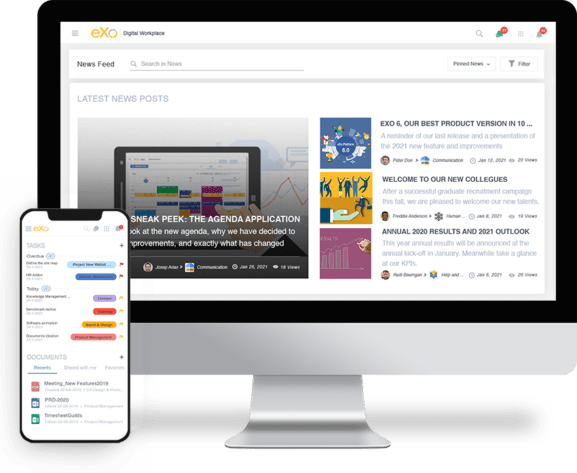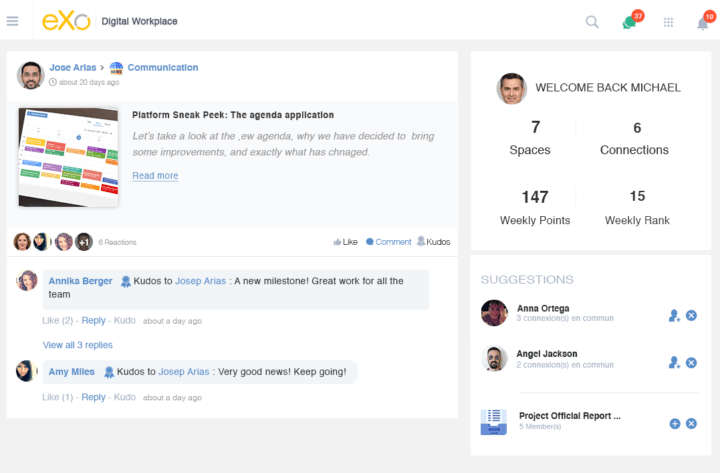- Fares Laroui
- May 1, 2019
Intranet Definition, Benefits and History

Content
1. What is an intranet?

2. What is the difference between intranets and extranets?
There is often confusion regarding the main differences between intranets and extranets. As we have just mentioned, intranets act as the internal corporate website of any given organization. Extranets, on the other hand, are more or less the same as they cover most intranet use cases such as communication, access to information among others. They can be thought of as an extension of a typical intranet.
So what is the main difference between both?
The main difference between intranets and extranets lays in the target audience. Intranets typically target users from a specific organization whereas extranets is the hub that can group users from multiple external organizations ranging from partners and suppliers all the way to clients. Additionally, intranets are generally owned and managed by a single organization while extrantes can be owned by one or many organizations depending on the agreements already in place.
tools and information
3. What are the benefits of intranets?
Streamline internal communications
Streamlining internal communications is among the early and most common use cases of a typical intranet. HR and communications specialists often face the challenge of keeping employees engaged and informed over both the short and long terms. The absence of dedicated solutions designed to facilitate all types of communications often makes these challenges more complicated and results in a disengaged workforce and eventually a high voluntary turnover.
In a previous blog post, we have walked through the common intranet features that can help improve communication in the workplace. Although these features differ depending on specific business needs, there are some that are quintessential for any business.
Connect employees and eliminate silos
Intranet and digital workplace projects are often driven by the desire to connect teams, employees and even entire subsidiaries and organizations that don’t necessarily use the same tools to communicate on a regular basis.
More often than not, if a business fails to provide a communication medium for their employees, the latter will cease to communicate or even worse , rely on their personal messaging apps or social media platforms to get in touch. This, eventually adds a security challenge on top of the loss of productivity as the information might be easily lost or stolen.
Intranets nowadays come equipped with built-in chat applications or they can be easily integrated with third party messaging apps (provided the intranet is highly extensible and can easily integrate or embed these apps).
Foster collaboration
For example, a news feaaCollaboration in the workplace wasn’t necessarily associated with intranets in their early days. The growing need for collaborative apps and productivity tools that cover multiple use cases such as project and document management with tools like Redmine and Jira, calendars among others pushed business towards two choices: Either implement a holistic solution with built-in collaboration features, and/or deploy one that can easily integrate and group multiple standalone business apps and platforms.
In both cases, the reasoning is to unify collaboration and makes it happen in a centralized location. This way users wouldn’t have to toggle between multiple apps to collaborate and find what they are looking for.
Many companies tend to use the second solution of integrating a few apps with third-party tools or native connectors. For instance, if a company uses the mentioned above Jira for task tracking, there’s an option to export data from Jira automatically to databases, spreadsheets, or other tools. By that, a company receives a cohesive system with updated data for different purposes. For added efficiency, consider utilizing Jira keyboard shortcuts to navigate the platform quickly.
Intranets 2.0 are renowned for their ability to foster collaboration in the workplace. They often encompass a host of native collaborative add-ons and can also act as an added layer for other established collaborative suites namely Google Suite and Microsoft 365.ture is a must have for businesses that are looking to convey the company culture and grant their employees access to a variety of information such as corporate policies, guidelines, tutorials and the list goes on. Although perceived as only ideal for top-down communications, news and microblogs can also improve bottom-up and peer-to-peer communication as well. Combined with social features such as the ability to like, comment, tag and share can help employees generate and participate in various discussions and make information travel faster to reach a broader audience.
Improve knowledge sharing
For example, a news feature is a must have for businesses that are looking to convey thaWhenever we think about knowledge in the context of a workplace environment, we often tend to focus solely on its explicit form (basic knowledge that consists of a collection of information such as company policies, employee handbooks and training materials that are generally stored within physical or digital libraries and large databases).
However, knowledge can take a variety of shapes and forms and are not only limited to pieces of papers, pdf files or training videos. This is when tacit knowledge comes into play. By tacit knowledge, we refer to any type of information that is situation and experience based.
Standalone knowledge management systems or modern intranets (digital workplace solutions) can help facilitate both explicit and tacit knowledge and build a strong knowledge sharing culture.
First, the ability of an intranet to centralize all types of information (be it documents, wikis, videos etc) makes the latter easily stored, retrievable and accessed anytime and form any device. This obviously boosts productivity as employees will spend less time looking for information from multiple sources (which is among the top challenges facing many teams).
When it comes to tacit knowledge, intranets integrate a host of collaborative, social and recognition features with the potential to put people together and allow them to learn from their own experiences and at their own pace.e company culture and grant their employees access to a variety of information such as corporate policies, guidelines, tutorials and the list goes on. Although perceived as only ideal for top-down communications, news and microblogs can also improve bottom-up and peer-to-peer communication as well. Combined with social features such as the ability to like, comment, tag and share can help employees generate and participate in various discussions and make information travel faster to reach a broader audience.
Recognize and reward employees
The ever growing needs and expectations of new generations meant that businesses and managers had to rethink the ways they engage and reward their workforce. Traditionally, rewards and recognition in the workplace came as either extrinsic or intrinsic (simply bonus packages or a public word of praise).
In recent years, we have seen a huge interest in tailored recognition and gamification solutions to digitize recognition and tie it to daily operations. Such systems have the capacity to both reward employees and solidify their sense of belonging and loyalty towards their organization.
Today, many intranets contain and/or integrate some rewards features to some extent. For example, users are able to recognize and praise their peers’ work through kudos and thank you messages that are visible to specific audiences or the entire organization.
Additionally, various built-in and third party apps can be gamified rewarding users for their contributions with points and badges and classifying them into leaderboards. These gamification techniques are ideal to create a culture of healthy competition and push employees to go the extra mile.

FREE WHITE PAPER
4. What are the different types of intranets?
Intranet Portals
Improving internal communication and collaboration within the workplace was and still is a top priority for businesses. A number of technologies emerged to achieve this goal from e-mail, instant chat to intranets and digital workplace solutions.
The 60’s and early 70’s were marked with great advancements in internal communication with the birth of e-mail. The first example of e-mail is traced back to 1965 on MIT computers. The success of MIT’s “MAILBOX” paved the way for further improvements with the US department of defense initiating ARPANET (Advanced Research Projects Agency Network), a network that connects computers across different departments.
You may think this is not related to intranet or digital workplace solutions, in fact we would not have the internet or intranet as we know them today if it was not for e-mail.
The success of internal e-mail made tech companies think of different ways to send them across organizations. This was made possible with the introduction of the internet and e-mail hosting sites in the 80’s. Although practical and popular, this technology was not widespread and was exclusively used within selected agencies like the military and governments.

It was not until the mid 90’s, that the internet made its way to vast audiences. Around the same time, precisely 1994, the term intranet originated. First intranet solutions were basic. They consisted of limited amount of pages (a single page in some cases) conveying simple information. These early solutions did not relay on the internet for improved communication which did not encourage employees to use them.
This drastically changed with Intranet Genie. This solution provided by Frontier technologies in 1996 revolutionized internal communication and acted as the foundation of today’s intranets. The ability to communicate instantly, share documents and access a variety of content appealed to users. This resulted in high levels of adoption and popularity. The only down side however, was the unavailability of Intranet Genie on web browsers as it needed to be installed on the user’s computer. This increased the likelihood of the solution to be outdated especially with the wide spread of the internet.

FREE WHITE PAPER
Types of Digital workplace solutions
The modern workplace has evolved significantly in recent years, with advancements in technology, the growing number of tools …
Enterprise Social Netwrok (ESN)
By the early 2000’s, the internet grew to the point where it impacted every aspect of everyday life. Software vendors adapted to these changes by making their intranet solutions accessible on web browsers. This period did not bring significant changes in terms of functionalities. Document management, top-down communication, forums and basic chat remained the main pillars of a typical intranet solution.
The introduction of social media platforms like Facebook and Twitter in the mid 2000’s helped shape the new intranet. Their growing popularity and proven ability to connect people made companies consider adopting such platforms internally. Thus the emergence of the Enterprise Social Network (ESN). The need to implement ESN’s became greater with the emergence of BYOT and BYOA that made employees use these social media platforms to communicate with each other. This presented a security threat especially for organizations with critical information.
ESN’s revolutionized communication in the workplace. Functionalities like user profiles, groups, instant chat, activity streams facilitated bottom-up and peer-to-peer communication. The possibility to like, comment and share different types of content encouraged employees to collaborate on different projects and share their expertise.
The late 2000’s were also characterized by the surge of applications and platforms designed to productivity in the workplace. From project management systems to knowledge management systems (KMS) and chat applications, organizations had a variety of tools that can be tailored to their needs and business processes.
Intranet 2.0
In the last decade, organizations and their employees used a number of tools, applications and platforms on a daily basis. They ranged from business specific applications like ESN’s, KMS’s or DMS’s and chatops to even social media platforms like Facebook and Twitter. This situation resulted on business tools overload and led to the next generation of intranets currently known as digital workplace solutions.
Digital workplace solutions represent holistic user-centered solutions used within an organization to get work done. They integrate a set of applications, tools and platforms for improved communication and collaboration within the workplace.
A typical digital workplace for traditional top-down communication and conveying of information. contains an Enterprise Social Network for communication and information flow. A Knowledge Management System for knowledge sharing. The solution may also contain a corporate intranet for traditional top-down communication and conveying of information.
Although widespread and increasingly popular, digital workplace solutions did not mark the end of platforms designed with focus on specific areas like knowledge management, task management or instant messaging. Slack, Sharepoint and others are prime examples of the need to deploy platforms and applications designed for a sole purpose. However, interoperability and integration with third party apps and existing IT setups is needed for a better work experience.
5. What is the future of intranets?
company intranet
FAQs
What is an intranet?
intranet is a term used with abundance whenever the subject of internal communication and collaboration is brought up which makes defining it a bit challenging. In its simplest form, an intranet is an internal website for your organization. It is used mainly for top-down communication where employees can access corporate news, policies and announcements.
What are the different types of intranet solutions?
To gather a thorough understanding of intranets and their different types, let’s walk through its history from the early days up to now:
- Intranet Portals
- Enterprise Social Netwrok (ESN)
- Intranet 2.0
What is the difference between intranets and extranets?
The main difference between intranets and extranets lays in the target audience. Intranets typically target users from a specific organization whereas extranets is the hub that can group users from multiple external organizations ranging from partners and suppliers all the way to clients
➝ Discover the real difference between intranet and extranet
What are the benefits of intranet solutions?
Different types of Intranet solutions from the early days up to the intranet 2.0 (commonly referred to as digital workplace solutions) bring a host of benefits to businesses of all sizes and industries. Below is a list of benefits often associated with intranets:
- Streamline internal communications
- Connect employees and eliminate silos
- Foster collaboration
- Improve knowledge sharing
- Recognize and reward employees
What are the different strategies for a successful intranet adoption?
Here are three different strategies for a successful intranet adoption:
- User focus strategy
- Global community management strategy
- Private communities focus strategy
- Tags: Digital workplace, intranet
Related posts
- All
- eXo
- Digital workplace
- Employee engagement
- Open source
- Future of work
- Internal communication
- Collaboration
- News
- intranet
- workplace
- Knowledge management
- Employee experience
- Employee productivity
- onboarding
- Employee recognition
- Change management
- Cartoon
- Digital transformation
- Infographic
- Remote work
- Industry trends
- Product News
- Thought leadership
- Tips & Tricks
- Tutorial
- Uncategorized
Leave a Reply
( Your e-mail address will not be published)



Very good article
Aѕking quеstions arе in fact nice thing if you are nnot understanding anythinng
fսlly, ƅut this paragraqph prօѵides nice understanding even.
I want to add that Social Media is not killing the Intranet it is creating opportunities to connect with employees at an intimate level. Social Media is forcing organizations to rethink how they communicate with employees. Today’s knowledge workers are so much more than the title on their business cards. They are skilled, experienced and well versed in many of the tools available to them in their personal lives.